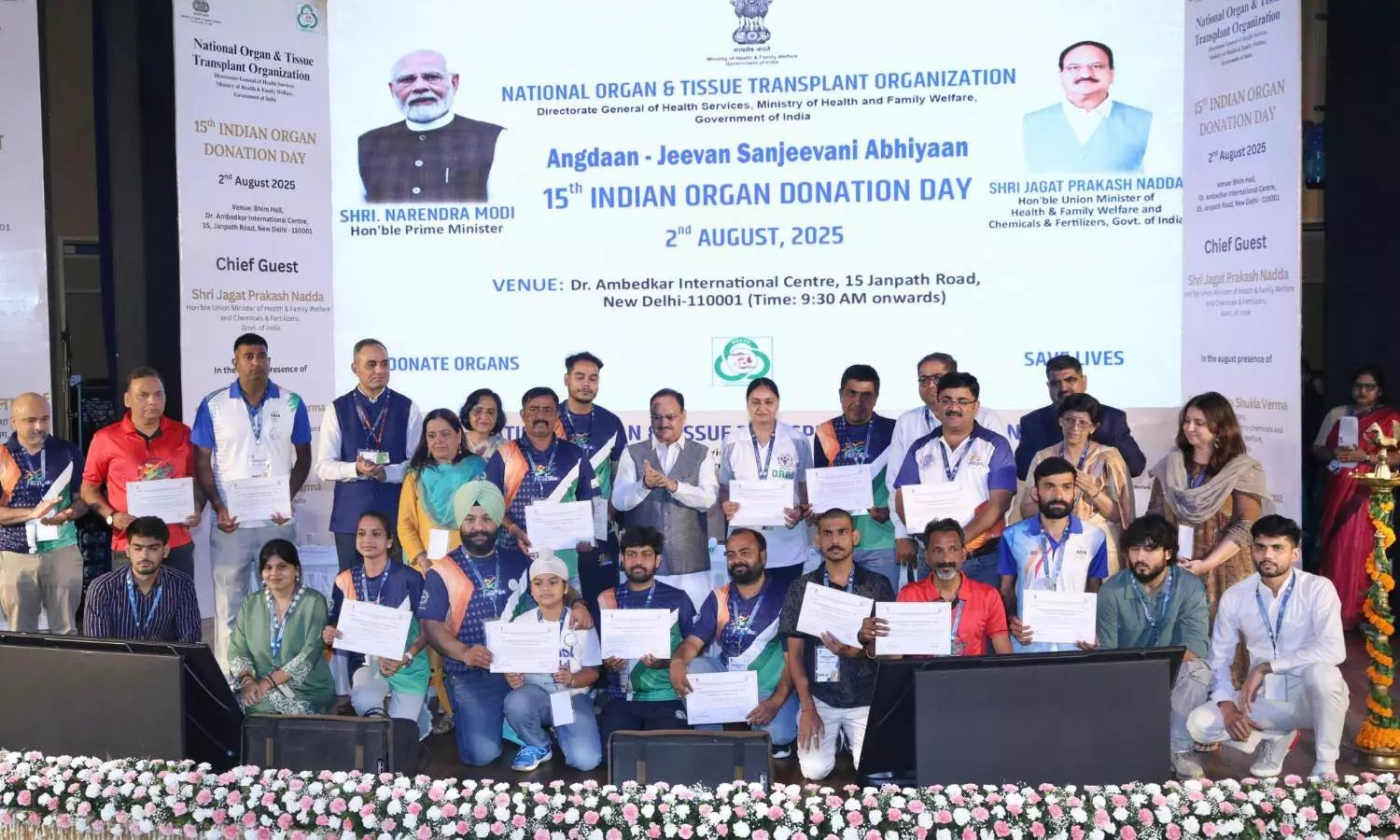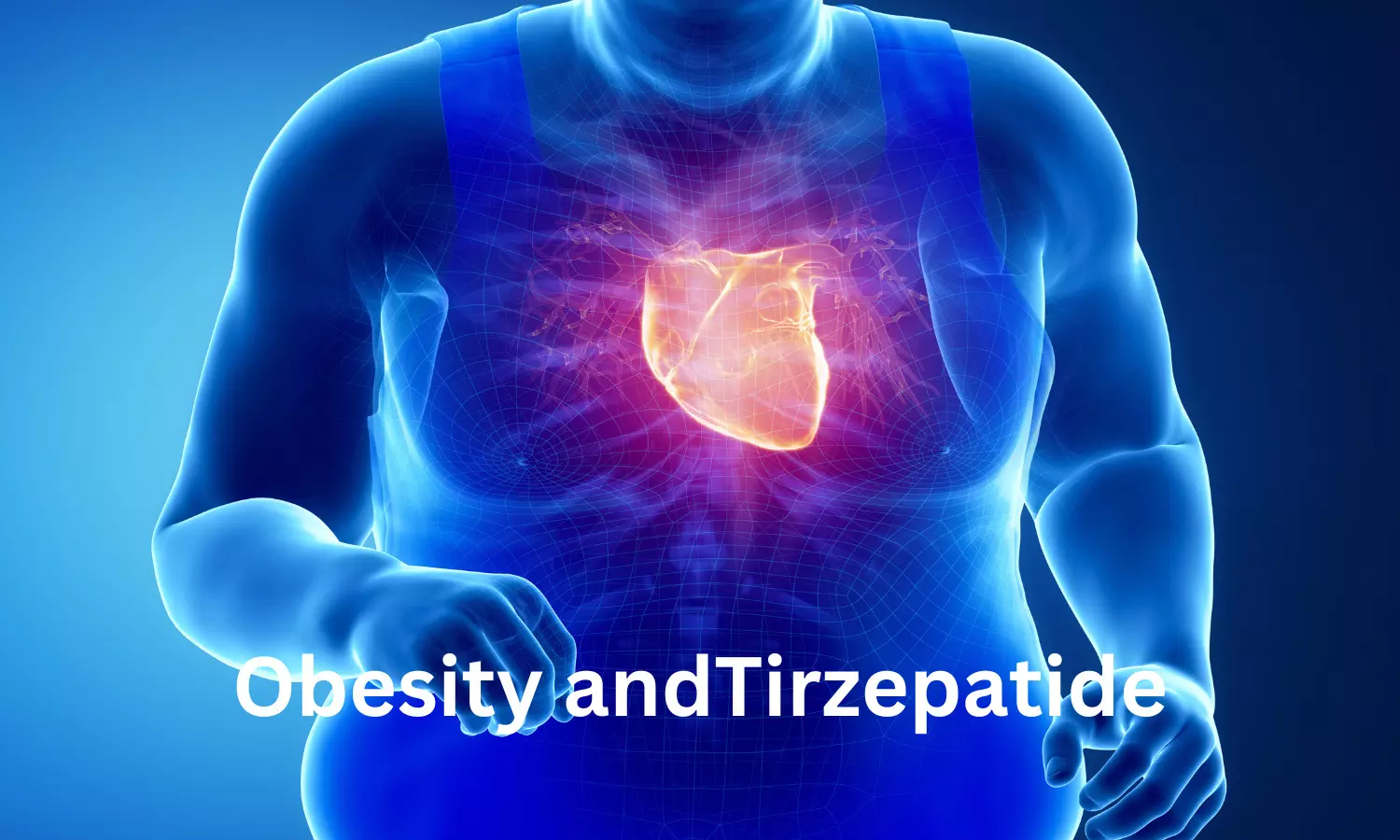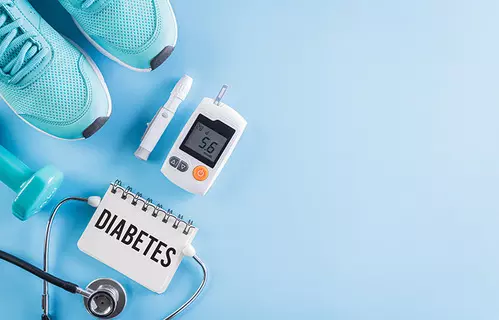Vagus nerve stimulation paired with meditation increases self-compassion and mindfulness benefits
Powered by WPeMatico
Powered by WPeMatico
Powered by WPeMatico
Powered by WPeMatico
Powered by WPeMatico
Powered by WPeMatico

New Delhi: Over 18,900 organ transplants were performed in 2024 in India – the highest in a single year, said Union Health Minister JP Nadda on Saturday.
He was speaking at the 15th Indian Organ Donation Day organised by the National Organ and Tissue Transplant Organisation (NOTTO) under the aegis of the Directorate General of Health Services, Ministry of Health, at Dr Ambedkar International Centre, here, news agency IANS reported.
Nadda stated that the government is continuously streamlining organ donation and transplant so that more and more citizens can benefit from it.
Also Read:AIIMS, PGI Chandigarh faculty get support from Doctors’ associations for Rotatory Headship
“Since the launch of the Aadhar-based NOTTO online pledge website in 2023, more than 3.30 lakh citizens have pledged their organs to donate, marking a historic moment in public participation,” the health minister said.
Noting that surge in pledge registration reflects a growing awareness, Nadda said that “India achieved a remarkable milestone of performing over 18,900 organ transplants in 2024, the highest ever recorded in a single year”.
This is a significant leap from fewer than 5,000 transplants in 2013.
As a result, “India ranks third globally in the total number of organ transplants, behind only the US and China,” Nadda said.
Calling “organ donation one of the noblest acts of humanity”, he urged people to make the “most profound contribution for someone else.”
The Minister also highlighted the alarming rise in cases of organ failures, posing a serious threat to public health and increasing strain on the healthcare system.
“Every year, thousands of people wait for organ transplants. Despite the urgent need, there remains a significant gap between the number of patients waiting for transplants and the number of available donors.”
“This gap is not due to a lack of willingness but often due to a lack of awareness and hesitation rooted in the myths and misconceptions. That’s why today is an important day which gives us a platform to spread awareness, encourage conversation and honour the donors and their families,” Nadda said.
Underlining the government’s efforts for organ transplantation, the minister stated that “to make organ transplant more accessible, financial support of up to Rs 15 lakh is provided to poor patients for transplantation of kidneys, liver, heart and lungs under the Rashtriya Arogya Nidhi”.
“Poor patients are provided support of up to Rs 10,000 per month after transplant to cover the medical expenses. Kidney transplant package has also been included in Ayushman Bharat Pradhan Mantri- Jan Arogya Yojana (AB PM-JAY),” Nadda added.
Also Read:Jharkhand to upgrade 6 District Hospitals into Medical Colleges
Powered by WPeMatico

A post hoc analysis of the SUMMIT trial, published in JACC, reveals that baseline body mass index (BMI) and fat distribution significantly affect the response to tirzepatide in patients with heart failure with preserved ejection fraction (HFpEF) and obesity. Patients who lost 15% or more of their body weight experienced greater improvements in exercise capacity, blood pressure, and weight. These findings highlight the importance of baseline BMI in predicting clinical outcomes with tirzepatide therapy. The study was conducted by Barry A. and colleagues.
Obesity is a well-documented cause of HFpEF, an entity of heart failure in which cardiac pumping function is maintained but relaxation and filling are impaired. Conventional treatment has been in this subset of patients. Tirzepatide, a weekly injectable medication, engages both the glucose-dependent insulinotropic polypeptide (GIP) and glucagon-like peptide-1 (GLP-1) receptors and is effective in weight reduction and metabolic regulation. The SUMMIT trial tested its impact in 731 obese (BMI ≥30 kg/m²) and HFpEF patients categorized under NYHA class II-IV. The patients were randomized to tirzepatide (n=364) or placebo (n=367) for 52 weeks.
This secondary analysis examined whether baseline severity of obesity (BMI) or distribution of obesity (WHR) had an effect on endpoints like cardiovascular death or HF deterioration, quality of life (KCCQ-CSS), 6-minute walk distance (6MWD), C-reactive protein (CRP), and body weight (BW). Cox regression and mixed-effects models were employed. Investigators also assessed the relationship between the magnitude of weight reduction and waist circumference decrease with tirzepatide and improvements in the major endpoints.
Key Findings:
• Younger, female patients with higher BMI had more volume overload, inflammation, and physical restriction. In BMI tertiles, tirzepatide always decreases cardiovascular death or worsening of HF risk with no heterogeneity by BMI or WHR stratum.
More increase in 6-minute walk distance:
• Estimated treatment difference (ETD): 9.9 m (low BMI) vs 26.3 m (middle BMI) vs 37.5 m (high BMI); P = 0.025
Greater weight loss:
• ETD: −10.7% vs −11.8% vs −14.4%; P = 0.006
Greater decrease in systolic BP:
• ETD: −1.00 vs −6.65 vs −6.62 mm Hg; P = 0.035
Trend towards improved quality of life (KCCQ-CSS):
• P = 0.097
In HFpEF patients with obesity, tirzepatide decreased the risk of heart failure events and cardiovascular death independent of baseline BMI or WHR. Increased BMI and WHR were linked to younger age, female gender, increased inflammatory burden, renal dysfunction, and poorer exercise capacity. These results validate the utilization of tirzepatide as an efficacious therapeutic agent for enhancing HFpEF outcomes in obese patients.
Reference:
Borlaug, B. A., Zile, M. R., Kramer, C. M., Ye, W., Ou, Y., Hurt, K., Murakami, M., Packer, M., & SUMMIT Trial Study Group. (2025). Impact of body mass index, central adiposity, and weight loss on the benefits of tirzepatide in HFpEF: The SUMMIT trial. Journal of the American College of Cardiology, 86(4), 242–255. https://doi.org/10.1016/j.jacc.2025.04.059
Powered by WPeMatico

An international team of researchers has made a key discovery: many children and young adults in Sub-Saharan Africa diagnosed with type 1 diabetes (T1D) may have a different form of the disease – one not caused by the immune system, unlike classic T1D. This discovery could change how diabetes is diagnosed, treated and managed across the region, paving the way for more accurate care and better outcomes.
The research was published today in Lancet Diabetes and Endocrinology.
“This is the first study across several Sub-Saharan African countries to use the same lab tests and genetic tools to learn more about type 1 diabetes. We’ve done similar research in the U.S. with different groups, but what’s exciting here is being able to compare results between Africa and the U.S.,” said the paper’s co-author Dana Dabelea, MD, PhD, Distinguished Professor and Associate Dean of Research at the Colorado School of Public Health on the University of Colorado Anschutz Medical Campus.
The researchers enrolled 894 participants with youth-onset diabetes from three African countries: Cameroon, Uganda and South Africa. They compared findings from this population with similar studies done in the U.S. in the same age range.
“It’s a really unique and important opportunity to explore the heterogeneity of T1D across countries and racial groups living in vastly different environments,” adds Dabelea, who is also the director of the Lifecourse Epidemiology of Adiposity and Diabetes (LEAD) Center at CU Anschutz.
The researchers found that many young people in Sub-Saharan Africa diagnosed with T1D often don’t have the usual markers in their blood (called islet autoantibodies) typically seen in people with T1D in other parts of the world. Specifically, 65% of participants with T1D in this region did not have islet autoantibodies.
Islet autoantibodies help distinguish T1D from other forms of diabetes, like type 2 or monogenic diabetes, which have different causes and treatments.
“This suggests that many young people in this region have a different form of T1D altogether and is not autoimmune in origin,” said Dabelea.
When the researchers compared this data to studies in the U.S., they found a smaller but significant proportion (15%) of Black participants diagnosed with T1D had a similar form of diabetes found in Sub-Saharan Africa – characterized by negative autoantibodies and a low T1D genetic risk score.
However, white Americans with T1D showed the typical autoimmune pattern, even if they didn’t have detectable autoantibodies, their genetics still pointed to autoimmune diabetes.
“The identification of this T1D diabetes subtype in Sub-Saharan African populations and among individuals of African ancestry in the U.S. suggests a potential ancestral or genetic link,” Dabelea notes. “These findings highlight the need to consider alternative etiologies in this group and a deeper understanding of the underlying mechanisms may provide important insights for future prevention and treatment strategies.”
Reference:
Katte, Jean Claude et al. Non-autoimmune, insulin-deficient diabetes in children and young adults in Africa: evidence from the Young-Onset Diabetes in sub-Saharan Africa (YODA) cross-sectional study, The Lancet Diabetes & Endocrinology.
Powered by WPeMatico

According to a meta-analysis published in the European Journal of Preventive Cardiology, foods rich in flavan-3-ols-such as cocoa, tea, and certain fruits-may help lower blood pressure. Flavan-3-ols, found in cocoa, tea, and certain fruits, show promise in improving blood pressure (BP) and vascular function, but are currently not used for cardiovascular prevention.
This meta-analysis evaluated the effects of flavan-3-ol-rich interventions on BP and endothelial function.PubMed was searched for randomized controlled trials (RCTs) published 1946-03/2024 on BP and flow-mediated dilation (FMD) after flavan-3-ol-rich food, beverage, or supplement intake. Random-effects meta-analysis of 109 publications including 145 RCTs and 5,205 participants was performed.
Results: Flavan-3-ol interventions included epicatechin, epigallocatechin-gallate, cocoa products, tea, grape extract, and apples delivering 586 mg (95%CI 510,662) total flavan-3-ols. Interventions decreased office (-2.8 [95%CI -3.9, -1.7]/-2.0 [-2.6, -1.3] mmHg) and 24h-ambulatory BP (-3.7 [-5.8, -1.6]/-2.6 [-4.5, -0.8] mmHg) after chronic repetitive consumption. Effects were larger with elevated and hypertensive baseline BP or categorical hypertension (office: -5.9 [-10.0, -1.8]/-2.7 [-4.4, -1.0] mmHg, 24h-ABP: -6.8 [-16.3,2.8]/-5.1 [-12.5,2.2] mmHg).
Meta-regression analysis confirmed that the magnitude of BP lowering was inversely related to baseline BP, but not to proportion of participants with CVD, diabetes mellitus, and study duration across all studies, and was dose-dependently related to epicatechin dose only in cocoa studies. FMD increased after acute (+2.0% [1.6,2.3]) and repetitive (+1.7% [1.3,2.2]) consumption independent of BP. Reported adverse events were minor and low (0.4%). The considerable heterogeneity of effect sizes (I2>50%) between studies was not explained by the investigated factors limiting the strength of evidence to ‘moderate’. Flavan-3-ol-rich foods considerably reduce elevated BP and improve endothelial function independent of blood pressure supporting their use for cardiovascular prevention.
Reference:
Vasiliki Lagou, Arno Greyling, Mario Ferruzzi, Simon S Skene, Joy Dubost, Ayse Demirkan, Inga Prokopenko, Julie Shlisky, Ana Rodriguez-Mateos, Christian Heiss, Impact of flavan-3-ols on blood pressure and endothelial function in diverse populations: a systematic review and meta-analysis of randomised controlled trials, European Journal of Preventive Cardiology, 2025;, zwaf173, https://doi.org/10.1093/eurjpc/zwaf173
Powered by WPeMatico

Frailty is a medically defined condition in older adults that increases vulnerability to everyday stresses, leading to a higher risk of falls, hospitalization and loss of independence. Warning signs of frailty include:
Because most of these signs have a direct link to how active someone is, walking is a particularly effective way to help older adults improve their overall health and quality of life and maintain independence for longer.
But a common question remains: How fast should older adults walk to see real benefits? Traditionally, the “talk test” has been used to guide walking intensity: people are encouraged to walk at a pace that makes it difficult to sing but still allows for comfortable conversation. However, this method is subjective and difficult to apply consistently.
A new study led by researchers at the University of Chicago Medicine found that walking slightly faster — 14 steps per minute more than a person’s usual pace — led to meaningful improvements in physical function among older adults who were frail or at risk of becoming frail. In a second study, the researchers developed and tested a smartphone app designed to accurately measure walking pace, making it easier to integrate this beneficial practice into daily life.
Walking cadence — the number of steps taken per minute — is an intuitive and pragmatic way to measure walking intensity. Daniel Rubin, MD, an anesthesiologist at UChicago Medicine, became interested in cadence because of his clinical experience evaluating older patients preparing for surgery.
“Older adults have a high risk of complications associated with surgery,” he said. “Traditionally, surgical teams have relied on physical function questionnaires to risk stratify patients, but I thought there must be a way to develop more objective metrics.”
In a secondary analysis of a randomized controlled trial, Rubin and his colleagues studied older adults classified as frail or prefrail. Participants were enrolled in structured walking programs within their retirement communities, guided and assessed by clinical research staff, and cadence was measured by a device fitted to their thigh. One group was encouraged to walk “as fast as safely possible,” while another group walked at their usual comfortable pace.
The study’s results showed clear benefits: those who increased their cadence by at least 14 steps per minute above their usual pace (to roughly 100 steps per minute) experienced substantial improvements in their functional capacity, demonstrated by their ability to walk longer distances in a standardized test.
“People who haven’t experienced frailty can’t imagine how big a difference it makes to be able to not get tired going to the grocery store or not need to sit down while they’re out,” Rubin said.
Building on these findings, Rubin’s team created a smartphone app called “Walk Test,” which they designed specifically for measuring walking cadence accurately.
“We didn’t necessarily trust smartphones’ built-in analytics,” Rubin said. “Instead, we built an app that uses a novel open-source method to analyze the data measured by the phone and lets us actively engage users in brief, deliberate walking tests, ensuring accurate measurement.”
Validation testing showed that the app counts steps per minute with exceptional accuracy, closely matching specialized, research-grade accelerometers. Rubin noted that Walk Test was designed for accessibility and user-friendliness in addition to accuracy.
“We wanted to make it as low-barrier as possible so it’s easy for older adults to use without additional equipment,” he said. “The people who need the most help are usually the least well-equipped to get started.”
The research highlights walking as a widely accessible exercise with substantial health benefits.
“Even casual walking had positive effects on our study participants,” Rubin said. But for those who are able, increasing their walking pace judiciously can yield even greater results.
To use cadence to guide your walking intensity, start by measuring your usual walking pace in steps per minute to establish a baseline. From there, try increasing your pace slightly to find a level that still feels comfortable but brisker.
To maintain a steady and elevated cadence, Rubin recommends using a metronome app to match your steps to a consistent beat. While the Walk Test app developed by the research team is not yet available to the public, metronome apps are a simple alternative that can help walkers stay on pace and track progress over time.
These methods can help integrate faster-paced walking into daily routines, offering a simple yet effective strategy to people who want to stay healthier and more independent as they age.
Reference:
Daniel S. Rubin ,Anthony Hung, Walking cadence as a measure of activity intensity and impact on functional capacity for prefrail and frail older adults, PLOS One, https://doi.org/10.1371/journal.pone.0323759
Powered by WPeMatico
